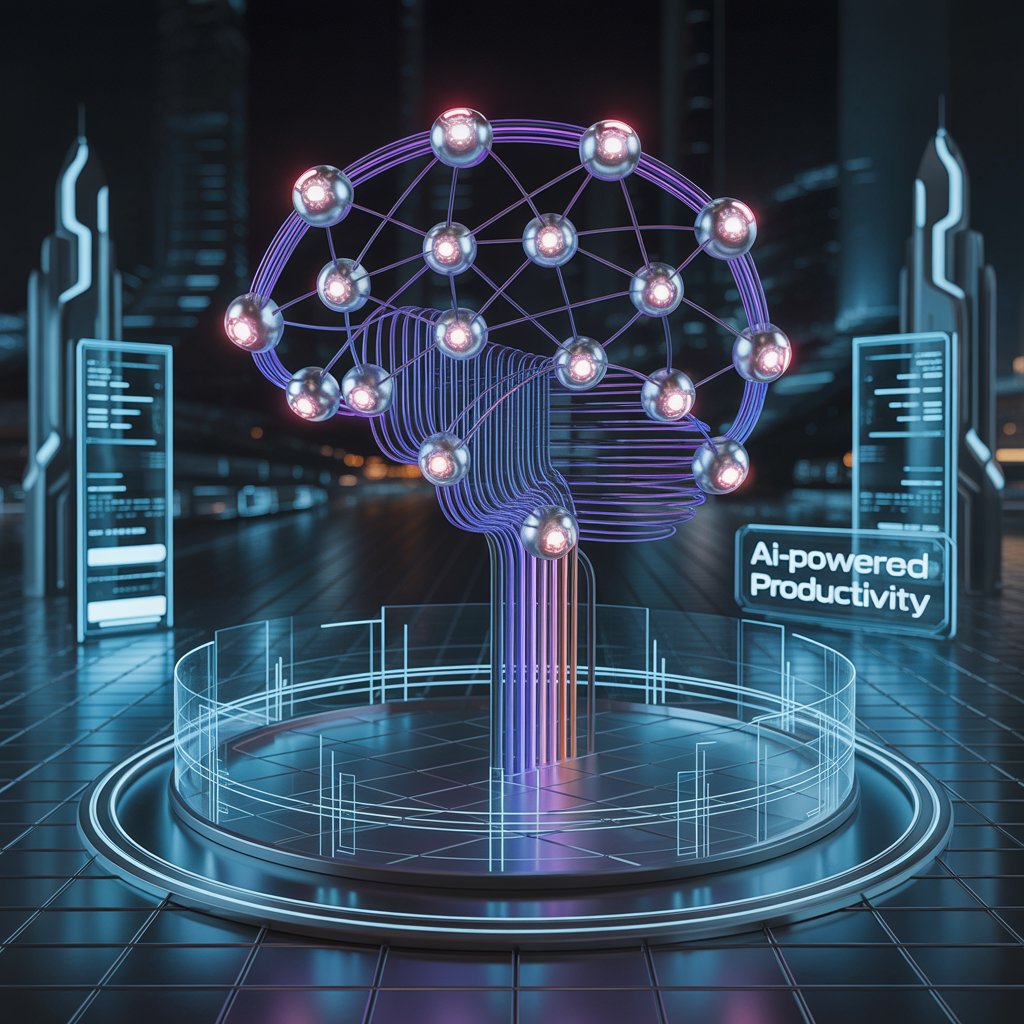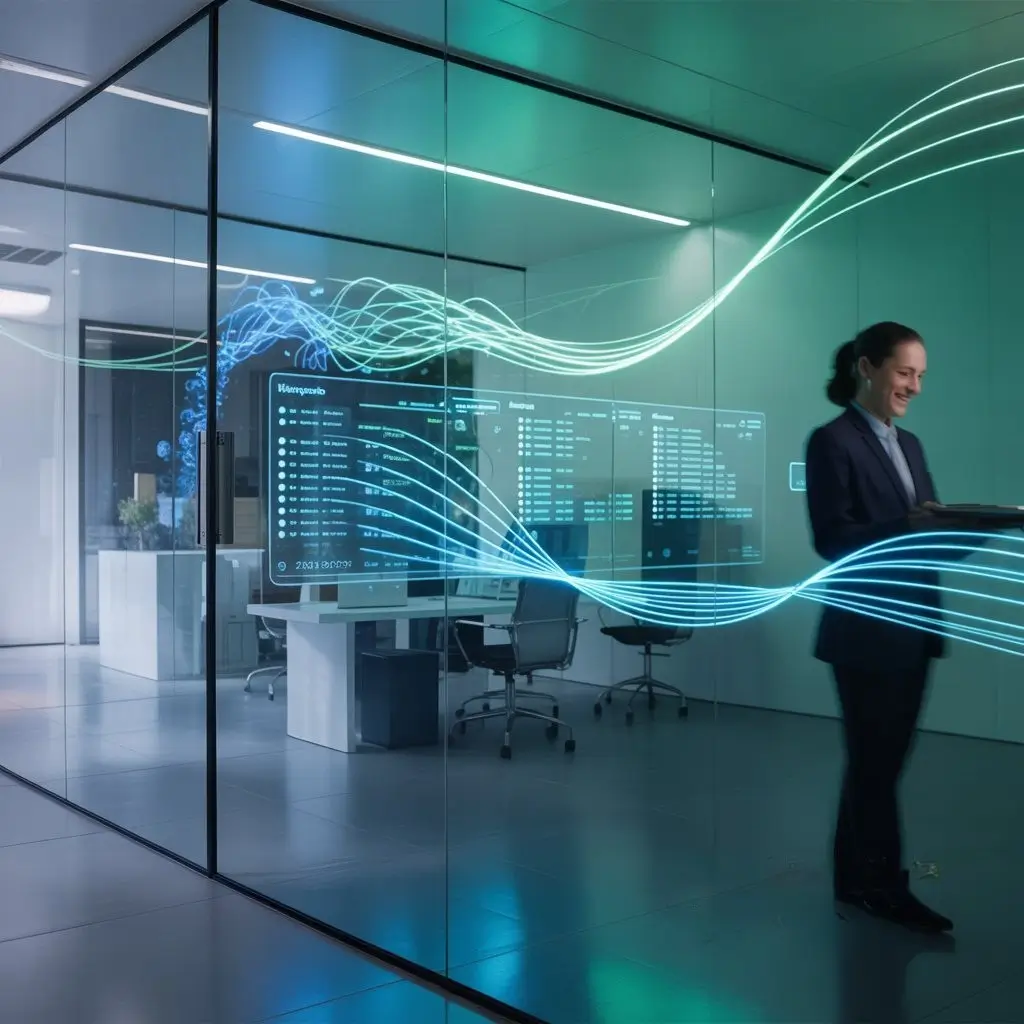Because the work environment is fast and competitive, productivity matters much more. There is increasing pressure for knowledge professionals, creatives, analysts and managers to finish their work promptly and to a high standard. Generative AI, a new technology, is changing the way we work now.
Generative AI refers to advanced machine learning models capable of creating new content, such as text, images, code, or even music, based on the data they have been trained on. In contrast to traditional AI, which mainly analyzes or organizes data, generative AI helps people by producing unique results for complex tasks. Popular examples include language models like ChatGPT, image generators like DALL·E, and various domain-specific AI tools.
The adoption of generative AI in workplaces is accelerating rapidly, driven by its potential to automate routine tasks, enhance creativity, and support decision-making. This technology is not just a futuristic concept; it is already proving to be a powerful productivity multiplier for skilled workers. Studies indicate that generative AI can boost individual productivity by up to 40%, enabling professionals to accomplish more in less time while maintaining or improving quality.
This article explores how generative AI is transforming productivity for skilled workers, the specific ways it adds value, real-world examples of its impact, and the challenges organizations must navigate to harness its full potential. Ultimately, generative AI represents a new frontier where human expertise and machine intelligence collaborate to unlock unprecedented levels of success.
Understanding Generative AI
Generative AI, which belongs to artificial intelligence, generates content by itself instead of only processing and examining existing information. Unlike traditional AI models that perform tasks such as classification, prediction, or pattern recognition, generative AI systems generate original outputs, whether that be text, images, audio, or even code, based on the patterns they have learned from vast datasets.
At the core of generative AI are advanced machine learning architectures like transformer models, which enable the system to understand context, semantics, and structure. For example, language models like OpenAI’s GPT series can produce coherent and contextually relevant text, while image generation models like DALL·E can create detailed visuals from textual descriptions.
Some popular generative AI tools include:
- ChatGPT: A conversational AI that can draft emails, write articles, answer questions, and assist with coding.
- DALL·E: An AI that generates images from textual prompts, useful for marketing, design, and creative projects.
- Codex: An AI model that helps programmers by generating code snippets based on natural language descriptions.
It is different from standard automation in that it uses learning from data to generate creative and adjuadjustedsting results. This capability allows it to assist skilled workers in creative and cognitive tasks that were previously thought to be uniquely human.
By understanding the foundational technology and capabilities of generative AI, organizations and professionals can better appreciate how it can be leveraged to multiply productivity and drive success in today’s knowledge-driven economy.
The Productivity Challenge for Skilled Workers
Skilled workers, often referred to as knowledge workers, are the backbone of modern economies. They engage in intellectual tasks such as analyzing data, developing strategies, solving complex problems, and making critical decisions that drive business success. However, despite their expertise, these workers face significant productivity challenges that hinder their ability to perform at peak levels.
Too much information available can be a major concern. Knowledge workers are inundated with vast amounts of data, from emails and reports to messages across multiple platforms, which consumes a disproportionate amount of their time. Instead of focusing on high-value activities, they spend hours managing and filtering information, leading to cognitive fatigue and reduced effectiveness.
Another major hurdle is the prevalence of repetitive and administrative tasks. Activities such as scheduling meetings, responding to routine queries, and compiling reports often take up valuable hours that could otherwise be dedicated to strategic or creative work. These low-impact tasks contribute to frustration and diminish overall productivity.
Decision fatigue also plays a critical role. The constant need to make numerous decisions throughout the day drains mental resources, increasing the likelihood of errors and burnout. Coupled with fragmented workflows, where work is scattered across numerous disconnected applications and tools, knowledge workers struggle to maintain focus and momentum.
Moreover, the rise of hybrid and remote work models, while offering flexibility, introduces new complexities in collaboration and communication, sometimes exacerbating inefficiencies and stress.
Addressing these challenges requires innovative solutions that go beyond traditional productivity tools. This is where generative AI and AI assistants come into play, offering the potential to alleviate information overload, automate routine tasks, and support better decision-making, thereby empowering skilled workers to reclaim their time and cognitive capacity.
How Generative AI Multiplies Productivity

Generative AI is proving to be a powerful productivity multiplier for skilled workers by augmenting their capabilities across multiple dimensions. Research shows that when used effectively within its capabilities, generative AI can boost a highly skilled worker’s performance by nearly 40% compared to those who do not use it►. This significant uplift stems from several key mechanisms:
Automation of Routine and Repetitive Tasks
Generative AI exceeds expectations at dealing with time-consuming, tedious exercises such as drafting emails, creating reports, summarizing information, and esseconducting ntial investigations. By automating these tasks, AI frees skilled workers to focus on higher-value, strategic, and creative work that requires human insight►. It saves you time and also helps avoid the mental tiredness that can come from routinely finishing the same tasks.
Enhancing Creativity and Idea Generation
AI acts as a brainstorming partner, helping professionals generate new ideas, designs, or solutions rapidly. For example, marketing teams can use AI to analyze trends and create multiple campaign concepts, while product developers can quickly prototype and iterate on designs. This accelerates innovation and expands the range of options explored►.
Improving Decision-Making and Problem-Solving
Generative AI is excellent at completing tasks that take time, like email writing, report generation, summarizing and basic studies. It supports scenario simulations, risk assessments, and predictive analytics, enabling skilled workers to make better-informed decisions faster►. This capability is particularly valuable in complex fields such as finance, healthcare, and engineering.
Personalized Learning and Skill Development
With AI, it’s easy to make preparation and learning materials for every person, which gives experts the edge to keep improving and perform well at work. This personalized approach fosters ongoing professional growth and adaptability in rapidly changing industries►.
Facilitating Collaboration and Communication
Generative AI can organize information, manage projects, and align team goals, improving communication and collaboration among distributed teams. AI helps teams work more efficiently by lowering the amount of friction and difficulty in their tasks.
Accelerating Content Creation and Coding
For writers, designers, and software developers, generative AI assists in producing high-quality content, code snippets, or design elements quickly. Tools like GitHub Copilot provide real-time coding assistance, speeding up development cycles and reducing errors►.
By leveraging these capabilities, generative AI empowers skilled workers to achieve more in less time, focusing their efforts on tasks that truly require human creativity and judgment. However, it is essential to use AI within its strengths, as performance can decline if AI is applied beyond its capabilities1. When integrated thoughtfully, generative AI not only multiplies productivity but also transforms how skilled professionals work and innovate.
Real-World Examples and Case Studies
Generative AI’s impact on productivity is not just theoretical, it is being demonstrated across industries with tangible results. Numerous organizations have successfully integrated generative AI tools to enhance efficiency, creativity, and decision-making, leading to measurable productivity gains and competitive advantages.
Walmart: Personalizing Customer Experience
Walmart deployed generative AI to analyze customer data and generate personalized marketing content, product recommendations, and dynamic website experiences. This approach significantly increased customer engagement, conversion rates, and satisfaction by tailoring interactions to individual preferences, demonstrating how AI can drive both productivity and business success in retail►.
Marketing Agency in Manchester
A medium-sized marketing agency struggling with burnout and project delays implemented generative AI tools like GPT-4 for brainstorming and drafting content. Within a year, their production capacity increased by 40% without adding staff, reducing employee stress and allowing the team to focus on creative strategy rather than repetitive tasks5.
Pharmaceutical Company Accelerating R&D
A global pharmaceutical firm integrated generative AI into its research process, using AI to draft hypotheses and analyze clinical trial data. This reduced R&D timelines by months, enabling faster product launches and providing a clear competitive edge►.
IT Department AI Chatbot
An IT department deployed a generative AI chatbot for internal HR queries. Initially sceptical, the team found the bot resolved over 85% of employee questions autonomously within six months, freeing HR staff to focus on strategic initiatives instead of routine inquiries►.
Broader Business Impact
According to McKinsey, introducing AI could bring $4.4 trillion in increases to productivity around the globe. Gartner reports that generative AI improves employee productivity by more than 30% on average by automating repetitive tasks, accelerating software development, and uncovering data-driven insights.
These examples highlight generative AI’s versatility across sectors, from retail and marketing to healthcare and IT, showcasing its ability to multiply productivity, improve quality, and foster innovation.
Challenges and Considerations

While generative AI offers significant productivity gains for skilled workers, its adoption also presents several challenges and important considerations that organizations must address to ensure sustainable success.
Psychological and Motivational Impacts
Research shows that while generative AI boosts immediate task performance and efficiency, over-reliance on AI can negatively affect workers’ intrinsic motivation and engagement. Employees may experience increased boredom and reduced satisfaction when performing tasks without AI assistance, potentially leading to disengagement and burnout over time. To mitigate this, companies should design workflows that blend AI-generated outputs with human creativity and judgment rather than fully automating tasks3.
High Implementation and Operational Costs
Deploying generative AI solutions can be expensive. Building custom AI models or integrating advanced tools often requires substantial upfront investments, sometimes reaching tens of millions of dollars, and ongoing costs per user can be significant. These financial burdens can make it difficult for organizations to justify AI projects solely on immediate productivity gains, especially when returns may materialize over a longer horizon►.
Data Quality and Risk Management
Effective generative AI depends on high-quality data. When data isn’t clear, risk controls are missing and governance is weak, AI can give out unreliable and biased results. Organizations must invest in robust data management and ethical frameworks to ensure AI systems operate transparently and responsibly►.
Ethical and Security Concerns
People are concerned about the use of intellectual property, privacy, and the potential for misuse with this technology. Companies must navigate these ethical challenges carefully, implementing strong security measures and compliance policies to protect sensitive information and maintain trust with employees and customers.
Balancing Automation with Human Oversight
Over-automation dangers decreasing basic human abilities such as inventiveness, problem-solving, and decision-making. Keeping up a adjust where AI increases instead of replaces human input is basic. Empowering workers to refine and personalize AI-generated work makes a difference protect their engagement and proficient development.
Addressing these challenges requires thoughtful strategy, ongoing evaluation, and a commitment to integrating AI in ways that enhance both productivity and employee well-being. As a result, companies can apply generative AI and try to control the threats it may introduce.
Future Outlook
The future of generative AI promises to further transform productivity and success for skilled workers, with rapid advancements expected by 2025 and beyond. Several emerging trends indicate how AI will become even more integral to the workplace:
Multimodal AI Integration
Generative AI is evolving from handling single data types, such as text or images, to seamlessly integrating multiple modalities like text, images, video, audio, and code in a single workflow. This will enable professionals to generate rich, cohesive content and prototypes faster and with greater creativity. For example, marketing campaigns could be automatically created with synchronized text, visuals, and video components, accelerating project timelines and enhancing impact►.
Autonomous AI Agents
AI systems are becoming more autonomous, and capable of planning, executing, and optimizing complex workflows with minimal human input. By 2025, many knowledge workers will routinely use AI copilots that remember context, learn from interactions, and manage multi-step tasks independently. This shift will further boost productivity by reducing manual oversight and enabling workers to focus on strategic decisions►.
Real-Time, Data-Aware AI
Next-generation generative AI will incorporate live data streams to produce dynamic, contextually relevant outputs in real-time. This capability will enhance personalization and decision-making accuracy across industries such as e-commerce, customer service, and finance. AI assistants will remember past interactions to provide continuity and tailored responses, making them more effective collaborators►.
Domain-Specific AI Models
Specialized generative AI models tailored to specific industries, like retail, manufacturing, healthcare, and finance, will drive deeper efficiencies and innovation. These models will optimize everything from personalized shopping experiences to predictive maintenance and supply chain management, delivering measurable productivity gains►.
Smaller, More Accessible AI Models
The rise of smaller, efficient generative AI models will democratize access to AI-powered productivity tools. These models will enable real-time, on-device AI applications that are faster, cost-effective, and scalable, expanding AI benefits beyond large enterprises to smaller businesses and individual professionals►.
Synthetic Data and Simulation
Generative AI will increasingly produce synthetic data and simulations to accelerate research and development, compliance testing, and market analysis. This will enable faster innovation cycles and risk mitigation, further enhancing organizational productivity ►.
In summary, generative AI’s future is marked by greater autonomy, multimodality, personalization, and domain specialization. As these technologies mature, skilled workers will be empowered to achieve unprecedented levels of productivity and success, transforming how work is done across industries. Organizations that proactively embrace these advancements will gain a critical competitive edge in the AI-powered economy.
Key Generative AI Trends Shaping Productivity and Success in 2025

As generative AI continues to evolve rapidly, several major trends are set to redefine how skilled workers and organizations harness AI to boost productivity and achieve success in 2025 and beyond.
The Rise of Multimodal Generative AI
Generative AI is moving beyond single data types to seamlessly integrate text, images, video, audio, and code within unified workflows. Next-generation models will produce cohesive, multimodal outputs in real-time, enabling professionals to create rich, interactive content faster than ever. For example, marketing teams will generate full multimedia campaigns from simple prompts, while product developers will produce written specs, 3D models, and functional code simultaneously. This shift unlocks new levels of efficiency and creativity across industries.
Autonomous Generative AI Agents
AI agents are becoming increasingly autonomous, capable of planning, executing, and optimizing complex, multi-step workflows with minimal human intervention. By 2025, many knowledge workers will rely on AI copilots that remember context, learn from interactions, and adapt dynamically, transforming how work is organized and completed. These agents will orchestrate end-to-end business processes, improving operational efficiency by up to 40% according to McKinsey►.
Real-Time, Data-Aware AI
Generative AI will integrate live data streams to produce dynamic, contextually relevant outputs. This real-time capability will enhance personalization and decision-making accuracy, especially in e-commerce, customer service, and finance. AI assistants will remember past interactions to provide continuity and tailored responses, making them more effective collaborators6.
Domain-Specific Models
Specialized generative AI models tailored for industries such as retail, manufacturing, and healthcare will drive deeper efficiencies and innovation. These models will optimize personalized shopping experiences, predictive maintenance, supply chain management, and more, delivering measurable productivity gains and cost reductions►.
Smaller, More Accessible AI Models
The emergence of smaller, efficient generative AI models will democratize AI-powered productivity tools, enabling real-time, on-device applications that are faster, cost-effective, and scalable. This trend will extend AI benefits beyond large enterprises to smaller businesses and individual professionals, fostering broader adoption and innovation►.
Generative AI will increasingly produce synthetic data and simulations to accelerate R&D, compliance testing, and market analysis. This capability will reduce reliance on costly real-world testing and enable faster innovation cycles, risk mitigation, and strategic planning►.
Synthetic Data and Simulation
These trends collectively signal a future where generative AI is deeply embedded in daily workflows, empowering skilled workers to achieve unprecedented productivity and success. Organizations that embrace these advancements strategically will gain a critical competitive edge in the evolving AI-driven economy.
Conclusion
Generative AI has transitioned from a futuristic concept to a transformative force reshaping productivity and success across industries in 2025. By automating routine tasks, enhancing creativity, and supporting smarter decision-making, generative AI acts as a powerful multiplier for skilled workers, enabling them to achieve significantly more in less time while maintaining high quality.
Real-world examples from sectors such as retail, marketing, healthcare, and IT demonstrate measurable productivity gains and innovation driven by AI adoption. However, realizing the full potential of generative AI requires addressing challenges including ethical considerations, data quality, implementation costs, and the balance between automation and human oversight.
Looking ahead, emerging trends like multimodal AI integration, autonomous AI agents, real-time data awareness, and domain-specific models promise to deepen AI’s impact on workplace productivity. Organizations that strategically embrace these advancements, invest in skills development, and prioritize ethical AI governance will position themselves for sustained success in the evolving AI-driven economy.
Ultimately, generative AI represents not just a tool but a collaborative partner, one that, when thoughtfully integrated, empowers skilled workers to unlock new levels of creativity, efficiency, and business value. The future of productivity and success is inseparable from the continued evolution and responsible deployment of generative AI.

